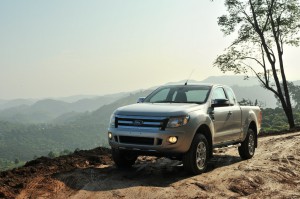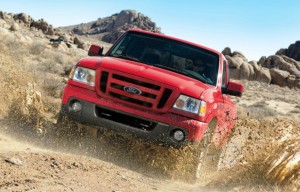
Ford still sells the Ranger around the world, but is reconsidering its decision to discontinue it in the U.S.
Ford Motor Co. may be ready to reverse its long-standing decision to abandon the compact American pickup market. But the maker is struggling to find a design that will offer a true alternative to the best-selling Ford F-150 full-size truck.
Ford walked away from the small pickup segment in December 2011, when it abandoned the long-in-the-tooth Ranger. And it wasn’t alone. With small truck sales withering over the decades, Chrysler and General Motors also pulled the plug on their old models.
But GM is back for 2015 with two new midsize pickups, the Chevrolet Colorado and GMC Canyon, and if initial reviews and early orders are any indication, they could be major hits, challenging the aged trucks offered by Toyota and Nissan.
Until recently, Ford officials, all the way up to CEO Mark Fields, were insisting the maker was out of the small truck market for good. In the U.S., anyway. Ford developed a new version of the Ranger for global markets, but it has cautioned that model is too close in size to the F-150, and would cost too much to produce in the States while not letting Ford charge enough to justify the investment.

If Ford brings the Ranger back to the U.S. market, it will be a compact truck like the last iteration, not a midsize truck like GM's new entries.
Ford has been betting that potential small truck buyers would instead opt for the bigger F-Series models.
But the launch of the GM trucks – and plans by Toyota and Nissan to redesign their Tacoma and Frontier models has apparently convinced Ford to reconsider its options, according to truck marketing manager Dave Scott.
“We’re looking at (new designs),” Scott told USA Today. “We think we could sell a compact truck that’s more like the size of the old Ranger, that gets six or eight more miles per gallon (than a full-size truck), is $5,000 or $6,000 less, and that we could build in the U.S. to avoid the tariff on imported trucks.”
The old Ranger was notably smaller than the new Colorado and Canyon models which are themselves about as large as GM’s full-size trucks where two generations ago. Today’s “small” trucks are really midsize models. Ford is considering the opportunities of kick-starting the true compact pickup segment that proved so wildly popular with the then-young Baby Boom generation.
(Truck, SUV sales driving down fuel economy average. For more, Click Here.)
As with just about every other market segment, however, those trucks grew steadily larger over the years.
But automakers also had to struggle with another challenge. To keep costs down, many older compact pickups were produced overseas. But they were subject to a hefty 25% import tariff colloquially known as the “Chicken Tax.” That made it costly to import such models and led Toyota, for one, to move production of the Tacoma to the U.S.
(Click Here for details on Bridgestone sucking the air out of its tires.)
As Scott noted, Ford would likely have to build a new truck in the States. It might then seek concessions from union workers to help hold down production costs. GM made a similar request of the United Auto Workers Union to justify moving production of its subcompact Chevrolet Sonic model back from Korea to a plant in the Detroit suburbs.
Scott also indicated Ford might opt for a unibody design with a new compact pickup, rather than the body-on-frame design of the F-Series and old Ranger. That would allow for a lighter, more fuel-efficient truck, and hold down production costs. It could make it easier to share the underlying platform with another Ford global product. Ford used that approach with its car-like Ranchero model based on a 1960s-era Falcon wagon.
(To see more about Audi’s plans for a spate of new hybrids, Click Here.)
But whether the market would accept that approach today remains to be seen. Honda tried a unibody design with its midsize Ridgeline truck. But despite strongly positive reviews, sales were dismal and Honda pulled the pickup from the market last year. It is now developing a replacement but is said to be adopting a more conventional design.
Ford officials haven’t given a firm go-ahead to a Ranger replacement for the U.S., and when such a model might actually roll into showrooms is uncertain but would likely take three to four years, according to knowledgeable industry sources.

If Ford doesn’t go unibody, what other small body-on-frame platform do they have?
I owned an 84 Ranger with the traditional Ford styling que’s. I still have my 91 Toyota 5th gen HiLux @ 253K. It’s been well used, carrying a load of sod home, my grandfather’s rock collection, etc. My father had a 67 El Camino with factory air shocks. THAT was a light duty machine. 283 V8/3 on the tree.
Fullsize trucks should be tested for steroid use.
It’s rediculous how big they are.
Back in the 90’s, purchase price and insurance cost was nearly the same for a compact truck well-equiped and a more base Full-size truck.
A compact truck needs to be able to carry something, and still get good MPG. Also if it is small enough to fit in the garage. My purchase parameters are: a 4 cylinder engine and a full 6 foot bed or maybe a little more. The Tacoma has a SHEET-MOLDED COMPOSITE bed, not steel, and I don’t like that. It’s too light at the back wheels. Until they make something I like, I’ll just keep driving my HiLux. (Red velvet ropes on brass posts protect it when in a parking lot !!)